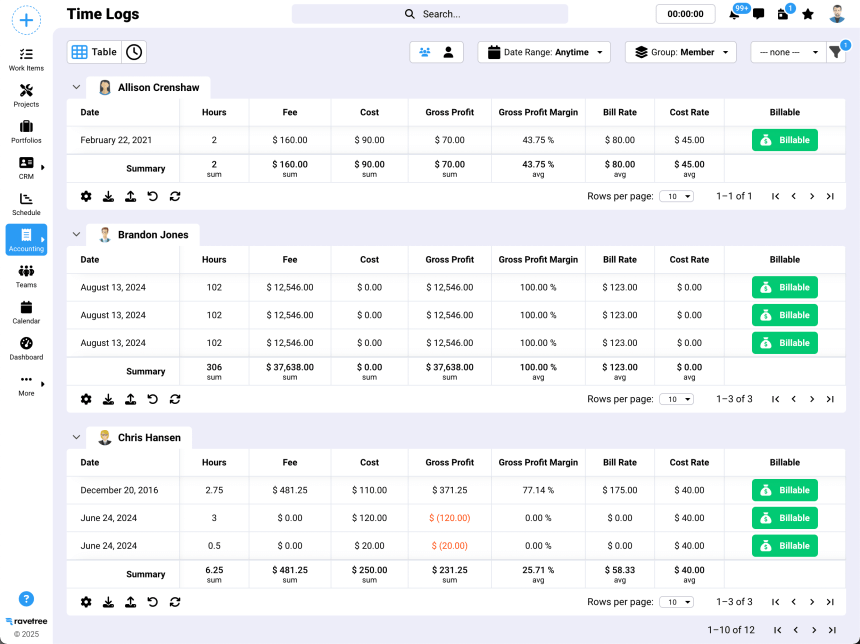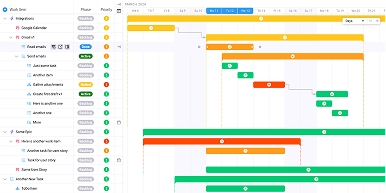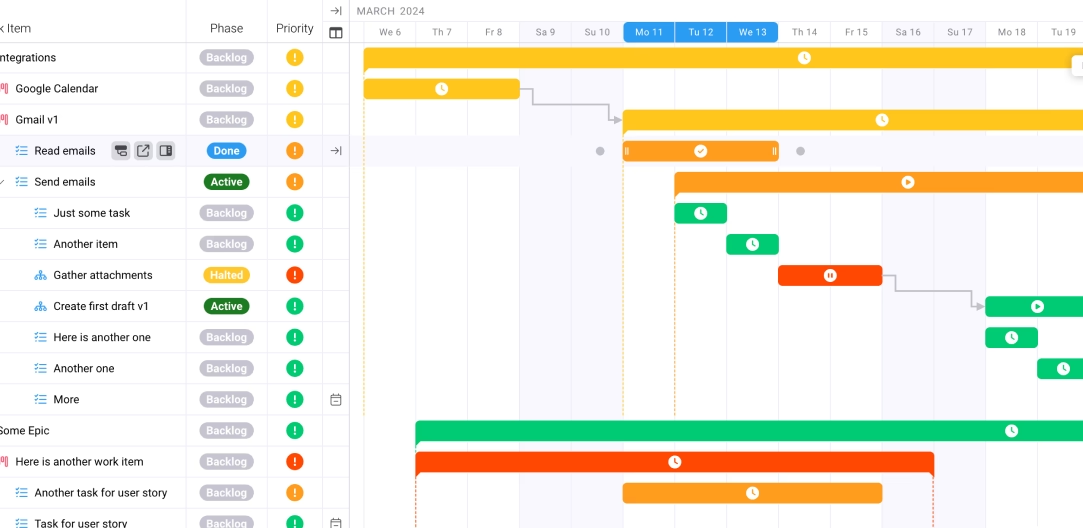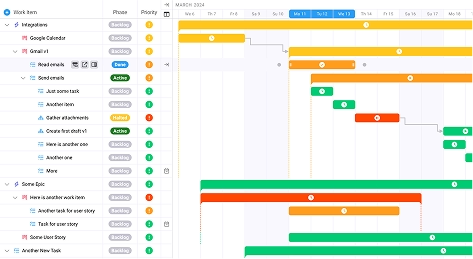
How to Choose the Right Work Management Platform for Your Agency
Key takeaways:
Here’s a counterintuitive truth that most agency leaders refuse to acknowledge: 70% of agencies are choosing work management platforms based on features they’ll never use, while ignoring the fundamental capabilities that actually drive profitability. This backwards approach to selecting a work management platform for your agency isn’t just wasting money—it’s actively undermining your team’s productivity and client satisfaction. The reality is that modern project management software can increase productivity by up to 50% while reducing project costs by 20%, yet most agencies continue making platform decisions based on flashy demos rather than strategic business needs.
The challenge facing today’s agencies isn’t finding a work management platform—it’s choosing the right work management platform for your agency that aligns with your specific operational requirements, team dynamics, and growth trajectory. This comprehensive guide will provide you with a proven framework to evaluate, select, and implement the optimal platform that transforms your agency’s efficiency rather than complicating it.
The Current Challenge: Why Most Agencies Choose the Wrong Platform
The statistics paint a sobering picture of how agencies approach platform selection. Despite workflow management systems representing a market projected to reach $307.64 billion by 2034, growing at an unprecedented 33.5% CAGR, most agencies are making decisions that actively hurt their bottom line.
The root problem lies in what industry experts call “feature fixation syndrome.” Agencies become mesmerized by sophisticated dashboards, advanced reporting capabilities, and AI-powered analytics—features that sound impressive in sales presentations but remain unused after implementation. Meanwhile, they overlook fundamental requirements like seamless client collaboration, intuitive time tracking, and integrated billing systems that directly impact daily operations and profitability.
Consider this reality check: only 2% of organizations have fully modeled all their business processes, while 62% have modeled less than 25% of their operations. This disconnect between platform capabilities and actual process understanding creates a dangerous blind spot in platform selection.
The consequence? Agencies end up with expensive, over-engineered solutions that create more friction than they eliminate. Teams resist adoption, client communications suffer, and what should be a productivity multiplier becomes a productivity drain.
The Strategic Framework: The SCALE Methodology for Platform Selection
Based on analysis of successful agency transformations and emerging industry trends, the SCALE methodology provides a systematic approach to choosing the right work management platform for your agency:
S – Stakeholder Analysis: Identify every person who will interact with the platform, from junior coordinators to C-suite executives and external clients.
C – Core Workflow Mapping: Document your agency’s essential processes, from lead generation through project delivery and invoicing.
A – Automation Potential: Evaluate which repetitive tasks consume the most time and could benefit from workflow automation.
L – Long-term Scalability: Assess how platform capabilities align with your 3-5 year growth projections and service evolution.
E – Economic Impact: Calculate total cost of ownership including implementation, training, and ongoing optimization.
This framework differs from traditional evaluation methods by prioritizing operational fit over feature abundance. It recognizes that AI and predictive analytics solutions are revolutionizing productivity management software, but only when properly aligned with actual business needs.
The SCALE methodology also acknowledges that successful platform selection isn’t just about software—it’s about organizational transformation. The global productivity management software market, valued at $62.06 billion in 2024, represents tools that can either accelerate or hinder your agency’s evolution.
Implementation Tactics: Five Critical Evaluation Strategies
1. Process-First Platform Mapping
Start by documenting your agency’s current workflows before evaluating any platform features. This process-first approach prevents feature fixation and ensures platform alignment with actual operational needs.
Map every client touchpoint, from initial consultation through project delivery and billing. Document pain points, bottlenecks, and manual workarounds that consume excessive time. This baseline understanding becomes your platform evaluation criteria.
The key insight here is that workflow automation can reduce operational expenses by 30% when properly implemented, but only if the platform addresses actual process inefficiencies rather than theoretical ones.
2. Multi-Stakeholder Trial Strategy
Implement a structured trial approach that includes every user type within your agency. Junior team members often interact with platforms differently than senior managers, and their adoption challenges can make or break implementation success.
Create specific trial scenarios that mirror real client projects. Test the platform under actual working conditions rather than sanitized demo environments. This real-world testing reveals usability issues and integration challenges that don’t surface during sales presentations.
Remember that remote collaboration tools can improve employee productivity by 30%, but only when teams actually embrace and consistently use the platform.
3. Integration Architecture Assessment
Evaluate how each platform integrates with your existing technology stack. The best work management platform becomes worthless if it creates data silos or requires manual data entry between systems.
Focus particularly on CRM integration, accounting software connectivity, and communication tool synchronization. These integrations determine whether your platform becomes a productivity multiplier or another administrative burden.
Consider that workflow automation trends show increasing adoption across agencies, meaning your chosen platform needs to complement, not compete with, existing automation investments.
4. Client Collaboration Capabilities
Agency success depends heavily on client satisfaction, making client portal functionality and communication features critical evaluation criteria. Your platform should enhance rather than complicate client relationships.
Test how easily clients can access project management updates, provide feedback, and approve deliverables through the platform. Evaluate whether the client experience aligns with your agency’s brand and service standards.
The goal is selecting a platform that makes client collaboration so seamless that it becomes a competitive advantage. Superior project management is essential for modern marketing teams, particularly when it strengthens client relationships rather than creating additional friction.
5. Financial Impact Analysis
Calculate the true cost of platform ownership beyond monthly subscription fees. Include implementation costs, training time, potential productivity losses during transition, and ongoing optimization expenses.
More importantly, quantify the expected return on investment through improved efficiency, reduced project overruns, and enhanced client satisfaction. Factor in billing system integration and time tracking capabilities that directly impact revenue recognition.
Consider both immediate efficiency gains and long-term scalability benefits. The best project management tool for agencies in 2025 should demonstrate clear financial benefits that justify the investment and transition effort, while avoiding platforms that serve current needs but can’t accommodate growth.

Measuring Success: KPIs That Actually Matter
Successful platform implementation requires measuring the right metrics at the right intervals. Focus on KPIs that directly correlate with agency profitability and client satisfaction rather than vanity metrics that look impressive in reports.
Immediate Impact Metrics (30-60 days):
- Time from project initiation to first deliverable
- Client communication response times
- Administrative task completion rates
- User adoption percentages across different roles
Operational Efficiency Metrics (60-90 days):
- Project delivery timeline adherence
- Budget variance reduction
- Client approval cycle times
- Team resource planning utilization rates
Strategic Growth Metrics (90+ days):
- Client retention rates
- Project profitability improvements
- New service offering feasibility
- Scalability stress test results
These metrics provide concrete evidence of platform value and identify areas requiring additional optimization. They also support data-driven decisions about feature utilization and process refinements.
The measurement approach should align with broader agency objectives. For example, COOs can optimize project management for marketing agency growth by focusing on metrics that support strategic goals rather than operational efficiency alone.
Future Considerations: Preparing for Platform Evolution
The work management platform landscape continues evolving rapidly, with AI-driven workplace transformation reshaping how agencies operate. Your platform selection should anticipate these trends rather than simply addressing current needs.
Consider platforms that demonstrate clear innovation roadmaps and regular feature updates. The best solutions evolve alongside industry trends rather than requiring replacement when new capabilities become essential.
Evaluate platform vendors’ commitment to integration development and API accessibility. Future agency success will increasingly depend on seamless data flow between specialized tools, making platform flexibility more important than comprehensive feature sets.
Pay attention to emerging project management trends for 2025 and beyond. Platforms that align with these trends position your agency for competitive advantage rather than technological obsolescence.
Most importantly, choose platforms that support rather than dictate your agency’s evolution. The best work management solutions adapt to changing business models rather than constraining growth opportunities.
Taking Action: Your Platform Selection Roadmap
Choosing the right work management platform for your agency requires disciplined evaluation and strategic thinking. The SCALE methodology provides structure, but success depends on honest assessment of your agency’s unique requirements and constraints.
Start with thorough process mapping before evaluating any platforms. Understanding your current workflows prevents costly mistakes and ensures platform alignment with actual operational needs. Remember that the most feature-rich platform becomes worthless if it doesn’t address your specific pain points.
Involve your entire team in evaluation and trial processes. Platform success depends on user adoption, which requires buy-in from every stakeholder level. The workplace productivity statistics clearly demonstrate that technology alone doesn’t drive results—engaged users do.
The work management platform market will continue expanding and evolving, but the fundamental principles of smart selection remain constant. Focus on operational fit over feature abundance, prioritize user experience over technical sophistication, and choose platforms that support your agency’s growth trajectory rather than constraining it.
Your agency’s success depends on making strategic technology choices that amplify human capabilities rather than replacing them. The right work management platform for your agency becomes an invisible foundation that enables exceptional client service and sustainable growth, while the wrong choice creates expensive friction that undermines everything you’re trying to achieve.









